Investing like a seasoned trend-following trader isn’t just about spotting market movements—it’s about mastering systematic strategies, disciplined risk management, and maintaining unwavering conviction. Bill Dunn, the visionary founder of Dunn Capital Management, has revolutionized the world of trend-following and managed futures with his innovative approaches and steadfast principles. In this comprehensive guide, we’ll explore Bill Dunn’s journey, delve into his core trading principles, and uncover the strategies that have made him a standout figure in systematic trading.
source: Top Trader’s Unplugged on YouTube
Bill Dunn: A Pioneer in Trend-Following and Managed Futures
Bill Dunn has profoundly impacted the realms of trend-following and managed futures through his strategic insights and disciplined methodologies. As the founder of Dunn Capital Management, Dunn has consistently demonstrated how systematic trading can achieve remarkable returns while effectively managing risk. His approach blends rigorous quantitative analysis with a deep understanding of market dynamics, setting a benchmark for traders and investors alike.

Understanding Dunn Capital Management and Its Significance in Systematic Trading
Dunn Capital Management stands as a testament to Bill Dunn’s commitment to systematic trading. The firm specializes in trend-following strategies, utilizing sophisticated algorithms and quantitative models to navigate various markets. By removing emotional biases and relying on data-driven decisions, Dunn Capital has carved out a niche in the competitive landscape of managed futures, delivering consistent performance and fostering trust among its clientele.
We’ll explore Bill Dunn’s trading strategies and his unique approach to trend-following. Whether you’re an aspiring trader seeking to refine your methods or an experienced investor looking to diversify your portfolio, understanding Dunn’s methodologies can provide valuable insights. We’ll break down his strategies, examine his risk management techniques, and offer practical steps to help you emulate his success in the dynamic world of trend-following trading.
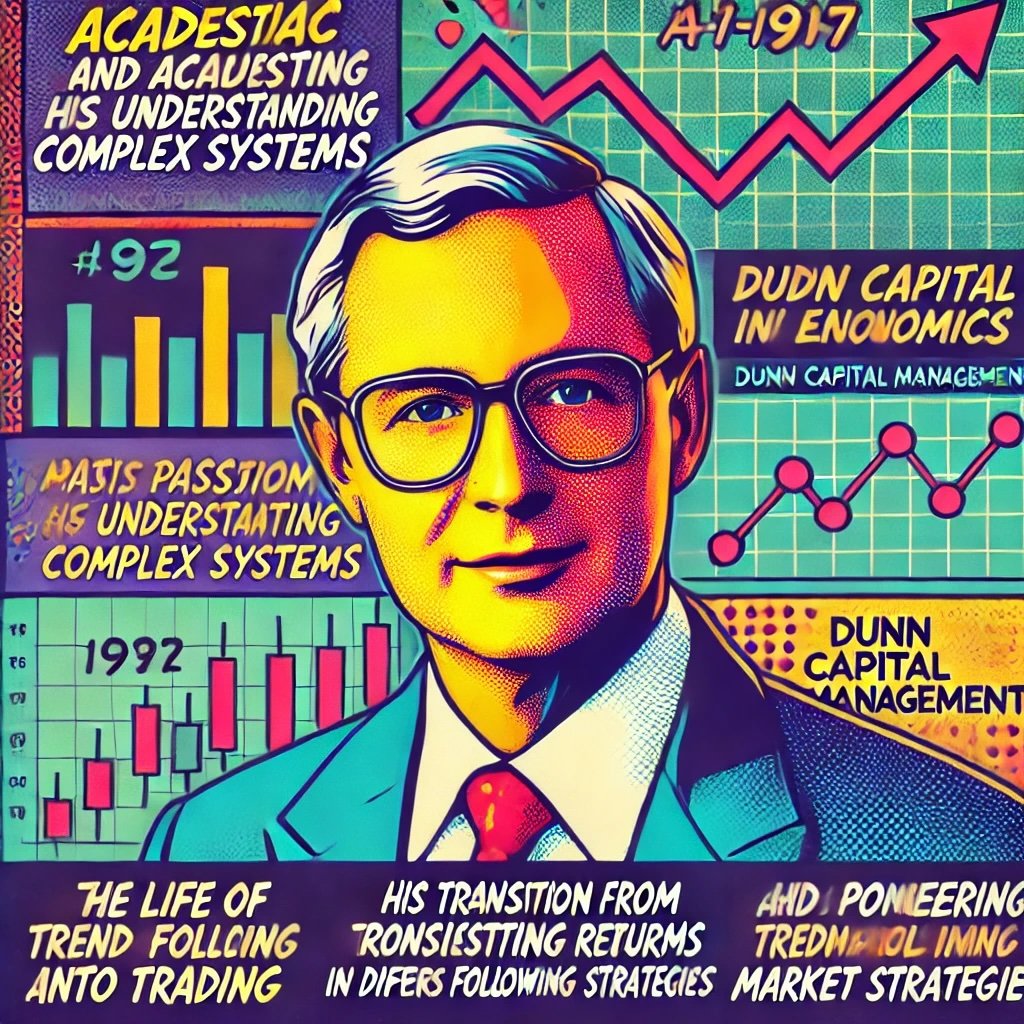
Who is Bill Dunn?
Background and Early Life of Bill Dunn
Bill Dunn’s journey into the financial markets began with a strong foundation in academia and a passion for understanding complex systems. Growing up, Dunn was always intrigued by patterns and the underlying mechanisms that drive various phenomena. This curiosity led him to pursue studies in mathematics and economics, providing him with the analytical skills essential for his future endeavors in trading.
His Journey from Academia to Becoming a Pioneer in Trend-Following
After completing his education, Bill Dunn ventured into the world of finance, where he initially focused on quantitative analysis. His academic background proved invaluable as he delved deeper into the intricacies of market behaviors and trading strategies. Dunn’s transition from academia to the trading floor was marked by his desire to apply theoretical knowledge to real-world trading, ultimately leading him to pioneer trend-following strategies that leverage systematic approaches.
Key Achievements, Including the Founding of Dunn Capital Management
- Founding of Dunn Capital Management: In 2006, Bill Dunn founded Dunn Capital Management, establishing a firm dedicated to systematic trend-following strategies. The firm quickly gained recognition for its disciplined approach and consistent performance.
- Consistent Performance: Under Dunn’s leadership, Dunn Capital has delivered impressive returns, outperforming many benchmarks in the managed futures space. The firm’s ability to navigate diverse market conditions has solidified its reputation as a leader in trend-following.
- Educational Contributions: Dunn has shared his expertise through numerous seminars, workshops, and publications, helping other traders understand and implement effective trend-following strategies.
- Industry Recognition: Bill Dunn is widely respected in the trading community for his innovative approaches and unwavering commitment to systematic trading, earning accolades and respect from peers and industry leaders alike.

The Development of Dunn Capital Management
Overview of Dunn Capital’s Founding and Its Growth in the Managed Futures Industry
Bill Dunn founded Dunn Capital Management with a clear vision: to harness the power of trend-following through systematic and quantitative methods. From its inception, Dunn Capital focused on developing robust trading systems that could identify and capitalize on long-term market trends across various asset classes. The firm’s dedication to research and innovation fueled its growth, allowing it to expand its offerings and attract a diverse clientele.
How Dunn’s Commitment to Systematic Trading and Discipline Shaped the Firm’s Success
Dunn Capital’s success is deeply rooted in Bill Dunn’s unwavering commitment to systematic trading and disciplined execution. By adhering to predefined trading rules and relying on data-driven strategies, Dunn Capital minimizes emotional biases and ensures consistency in its trading operations. This disciplined approach not only enhances performance but also builds trust with clients who seek reliable and transparent trading solutions.
Key Milestones and Performance Highlights of Dunn Capital Management
- 2006: Establishment of Dunn Capital Management, marking the beginning of a new era in systematic trend-following trading.
- 2010: Achieved significant returns by effectively navigating the volatile markets post the 2008 financial crisis, showcasing the resilience of trend-following strategies.
- 2015: Expanded operations globally, tapping into international markets and diversifying the firm’s trading portfolio.
- 2020: Successfully managed through the COVID-19 pandemic-induced market turmoil, demonstrating the robustness of Dunn Capital’s risk management and trend-following methodologies.
- 2023: Celebrated a decade of consistent performance, reinforcing Dunn Capital’s position as a leader in the managed futures industry.
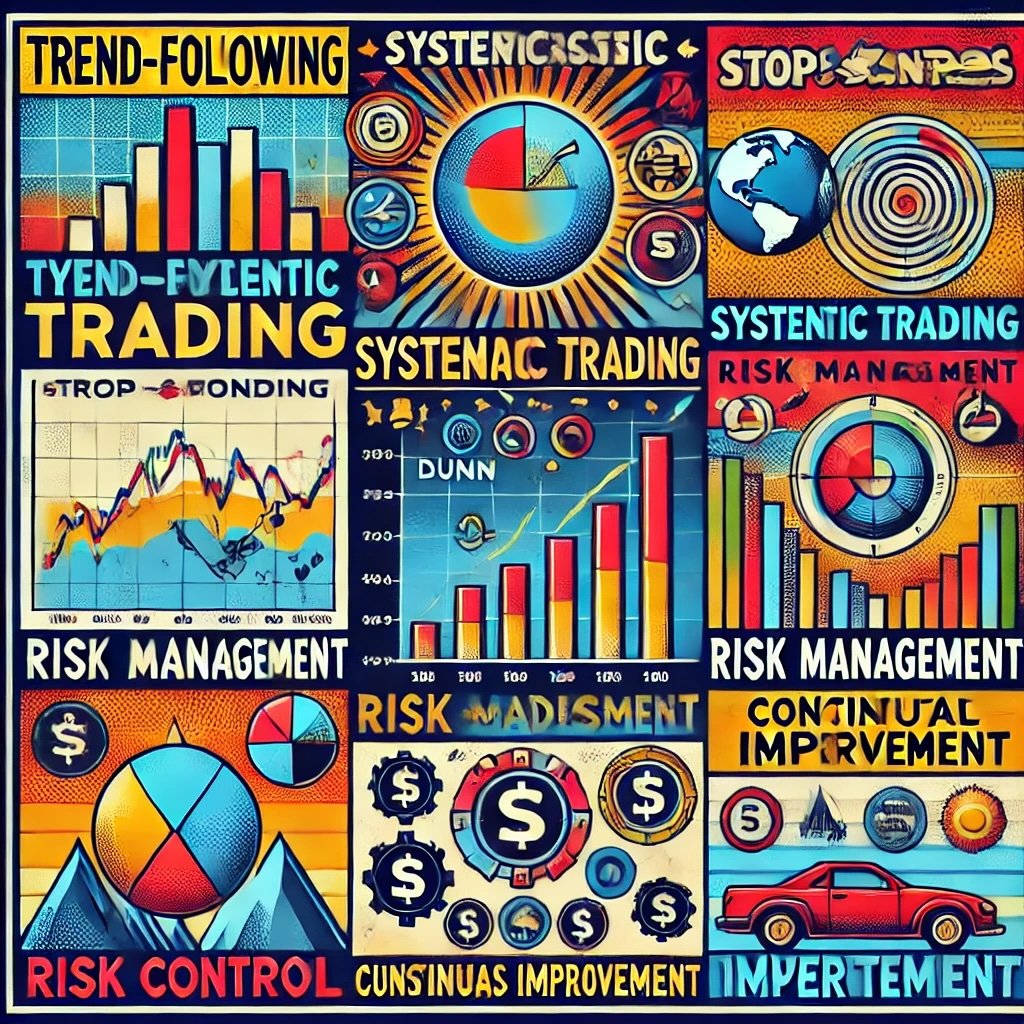
Core Principles of Bill Dunn’s Trading Strategy
Bill Dunn’s trading strategy is built upon a solid foundation of core principles that guide his decision-making process. These principles ensure that his trading remains disciplined, data-driven, and adaptable to changing market conditions.
Trend Following: Emphasis on Identifying and Riding Long-Term Market Trends
Understanding Trend Following: Trend following is a strategy that seeks to capitalize on sustained market movements. By identifying and following the prevailing trend, traders can maximize their returns while minimizing the risks associated with market reversals.
Key Components of Dunn’s Trend-Following Approach:
- Trend Identification: Utilizes moving averages, trendlines, and other technical indicators to identify the direction and strength of market trends.
- Entry and Exit Points: Establishes clear criteria for entering and exiting trades based on trend signals, ensuring timely and informed decision-making.
- Momentum Indicators: Incorporates momentum indicators like the Relative Strength Index (RSI) and Moving Average Convergence Divergence (MACD) to confirm trend strength and potential reversals.
Example: When Dunn’s system identifies a consistent upward trend in a commodity, he enters a long position, riding the trend until indicators suggest a potential reversal. This disciplined approach ensures that positions are held only as long as the trend remains favorable.
Tip: Focus on identifying and following robust market trends. Utilize technical indicators to confirm trend direction and strength before entering trades to enhance the probability of success.
Systematic Trading: The Importance of Removing Emotions and Relying on Data-Driven Systems
What is Systematic Trading? Systematic trading involves using predefined rules and algorithms to execute trades. This approach minimizes emotional biases, ensuring that trading decisions are based on objective data rather than subjective feelings.
Key Elements of Dunn’s Systematic Trading:
- Algorithmic Execution: Employs advanced algorithms to execute trades automatically based on predefined criteria, ensuring consistency and speed.
- Data-Driven Decisions: Relies on quantitative data and statistical analysis to inform trading strategies, reducing the influence of human emotions.
- Automation: Utilizes automated systems to monitor market conditions and execute trades, eliminating the delays and errors associated with manual trading.
Example: Dunn’s trading system automatically enters a trade when specific trend criteria are met, such as a breakout above a moving average with increased volume. The system also automatically sets stop-loss orders and profit targets, ensuring disciplined risk management.
Tip: Develop and adhere to a systematic trading plan that relies on quantitative data and predefined rules. Automation can help maintain discipline and consistency in executing your strategies.
Risk Management: Focus on Strict Risk Controls, Including Position Sizing and Stop-Loss Strategies
The Pillars of Risk Management: Risk management is essential for preserving capital and ensuring long-term trading success. Dunn’s approach emphasizes controlling downside risk through position sizing, diversification, and the use of stop-loss strategies.
Key Risk Management Techniques:
- Position Sizing: Determines the appropriate size of each trade based on the overall portfolio size and risk tolerance, preventing any single trade from having an outsized impact.
- Stop-Loss Orders: Sets predefined price levels at which trades are automatically exited to limit potential losses.
- Diversification: Spreads investments across various asset classes and markets to mitigate the impact of any single market’s poor performance on the overall portfolio.
Example: Dunn allocates a specific percentage of his portfolio to each trade based on the volatility and risk profile of the asset. If a trade moves against him, the stop-loss order triggers an exit, limiting the loss and preserving capital for future opportunities.
Tip: Implement strict risk management protocols, including position sizing and stop-loss orders, to protect your capital and sustain long-term trading performance.
Diversification: How Dunn Diversified Across Markets and Timeframes to Manage Risk and Enhance Returns
The Role of Diversification: Diversification involves spreading investments across different asset classes, markets, and timeframes to reduce risk and enhance potential returns. By not putting all eggs in one basket, Dunn ensures that his portfolio remains resilient against market volatility and sector-specific downturns.
Key Diversification Strategies:
- Asset Class Diversification: Invests in a variety of asset classes, including equities, commodities, currencies, and fixed income, to spread risk and capture opportunities across different markets.
- Geographic Diversification: Allocates investments across different geographic regions to mitigate the impact of regional economic downturns or geopolitical events.
- Timeframe Diversification: Employs strategies across different timeframes, such as short-term and long-term trend-following, to balance immediate opportunities with sustained growth.
Example: Dunn’s portfolio includes a mix of commodities like oil and gold, equities from various sectors, and currency pairs. This diversification ensures that losses in one area can be offset by gains in another, maintaining overall portfolio stability.
Tip: Diversify your portfolio across multiple asset classes, geographic regions, and timeframes to manage risk effectively and capitalize on a wide range of market opportunities.
Continuous Improvement: Hull’s Commitment to Refining and Improving Trading Systems and Strategies
The Importance of Continuous Improvement: Markets are dynamic and constantly evolving, necessitating the continuous refinement and improvement of trading systems and strategies. Dunn’s commitment to innovation ensures that his trading approach remains effective and adaptable to changing market conditions.
Key Practices for Continuous Improvement:
- Ongoing Research: Invests time and resources into researching new trading models and strategies to enhance performance.
- Performance Analysis: Regularly analyzes trading performance to identify strengths and areas for improvement, refining strategies accordingly.
- Adaptation to Change: Adjusts trading systems in response to market changes, ensuring that strategies remain relevant and effective.
Example: After identifying that a particular trend-following model underperforms during low-volatility periods, Dunn develops and integrates a new model tailored to those conditions, improving overall trading performance.
Tip: Embrace a mindset of continuous learning and adaptability. Regularly evaluate and refine your trading strategies to ensure they remain effective in evolving market environments.

Famous Trades and Market Calls
Analysis of Some of Dunn’s Most Notable Trades and Market Predictions
Bill Dunn’s trading career is adorned with remarkable trades and insightful market predictions that have cemented his reputation as a top trend-following trader. His ability to anticipate market movements and execute precise trades has led to significant successes and set benchmarks in the managed futures industry.
Notable Trades:
- Commodity Rally Capitalization: During a sustained bull market in commodities, Dunn’s trend-following system identified strong upward trends in sectors like energy and metals. By systematically increasing positions in these rising markets, Dunn capitalized on the prolonged upward movement, generating substantial returns.
- Global Equity Trends: Dunn’s system detected emerging trends in global equity markets, particularly in developing economies. By allocating capital to these growing markets, he benefited from the accelerated growth and robust performance of these equities.
- Currency Strength Trades: Identifying long-term trends in currency movements, Dunn strategically invested in appreciating currencies while shorting those showing persistent weakness. This approach allowed him to leverage forex market inefficiencies for profit.
- Interest Rate Speculations: Anticipating shifts in global interest rates, Dunn adjusted his portfolio to benefit from rising and falling rates. By following trends in interest rate-sensitive securities, he navigated the complexities of rate movements effectively.
How His Trend-Following Approach Led to Significant Successes
Dunn’s trend-following approach, grounded in systematic analysis and disciplined execution, has been instrumental in his trading successes. By relying on objective data and predefined rules, Dunn minimizes the influence of emotions and maximizes the potential for capturing profitable trends.
Key Factors in His Success:
- Objective Decision-Making: Utilizes quantitative models to make data-driven trading decisions, reducing the impact of emotional biases.
- Disciplined Execution: Adheres strictly to his trading plan and risk management protocols, ensuring consistency and long-term profitability.
- Adaptive Strategies: Continuously refines and adapts trading strategies to align with evolving market conditions, maintaining relevance and effectiveness.
- Technology Integration: Leverages advanced trading systems and algorithms to execute trades with speed and precision, capitalizing on fleeting market opportunities.
Example: During a period of economic recovery, Dunn’s system identified a strong upward trend in industrial commodities. By systematically increasing positions in these commodities, Dunn captured the sustained upward movement, resulting in significant portfolio growth.
Tip: Maintain a disciplined trend-following approach, relying on data-driven signals and predefined rules to navigate market trends effectively and capitalize on profitable opportunities.
Lessons Learned from These Trades and Their Relevance Today
1. Importance of Systematic Approaches: Dunn’s successes underscore the value of systematic trading approaches. By relying on predefined rules and quantitative models, traders can achieve consistency and reduce the influence of emotional biases.
2. Robust Risk Management is Crucial: Effective risk management protects capital and sustains long-term trading success. Dunn’s emphasis on position sizing and stop-loss strategies ensures that losses are limited and capital is preserved for future opportunities.
3. Adaptability Enhances Performance: Markets are dynamic, and the ability to adapt trading strategies to changing conditions is essential. Dunn’s continuous improvement mindset allows his strategies to remain effective amidst evolving market landscapes.
4. Diversification Mitigates Risk: Diversifying across multiple asset classes and markets reduces exposure to any single market’s volatility, enhancing portfolio stability and performance.
Tip: Incorporate the lessons learned from successful traders like Dunn into your own trading approach. Focus on developing systematic strategies, implementing robust risk management, maintaining adaptability, and diversifying your portfolio to achieve sustained trading success.
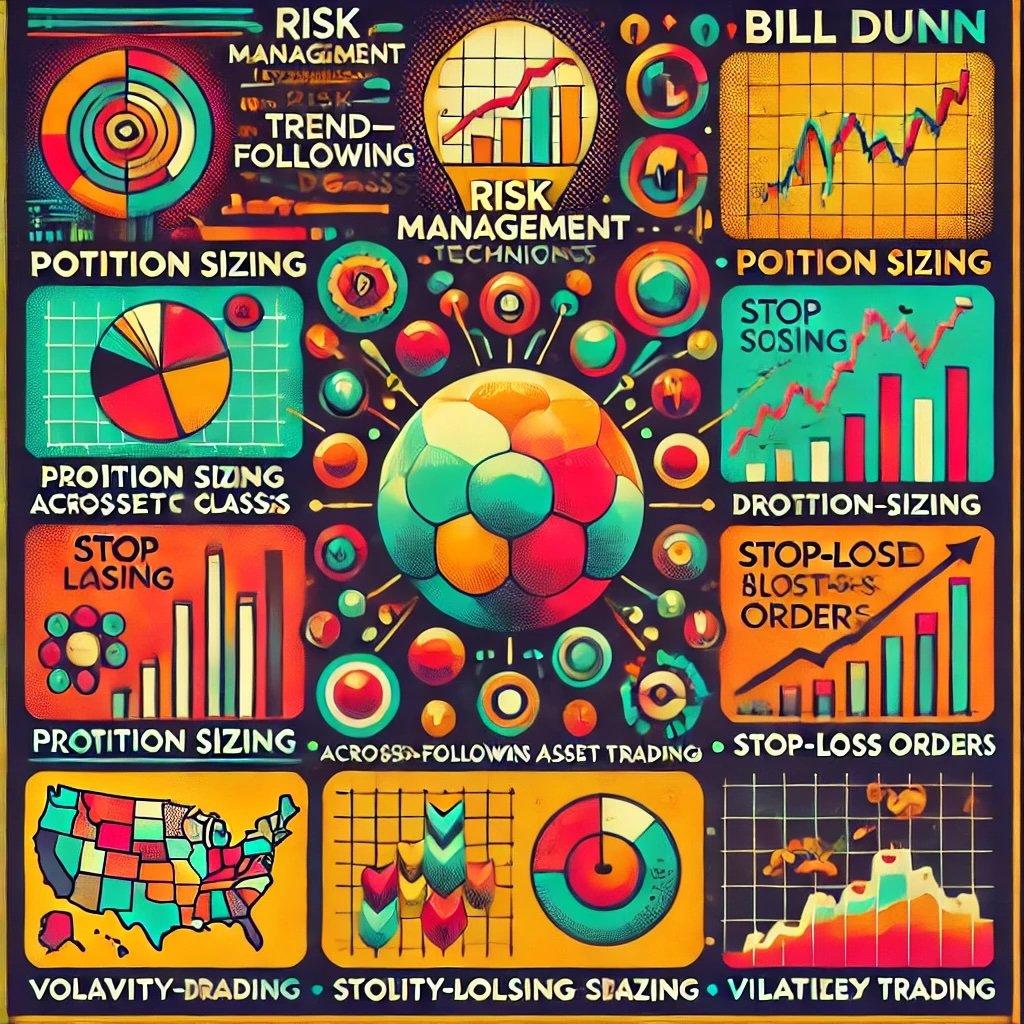
Risk Management Techniques
Detailed Look at Dunn’s Approach to Managing Risk in Trend-Following Trading
Risk management is a cornerstone of Bill Dunn’s trading strategy. By implementing comprehensive risk management techniques, Dunn ensures that his capital is protected and his portfolio remains resilient against market volatility.
Key Components of Dunn’s Risk Management:
- Position Sizing: Determines the appropriate size of each trade based on the overall portfolio size and risk tolerance, preventing any single trade from having an outsized impact.
- Diversification: Spreads investments across various asset classes and markets to mitigate the risk associated with any single investment.
- Stop-Loss Strategies: Implements strict stop-loss orders to limit potential losses and protect capital from significant downturns.
- Volatility-Based Position Sizing: Adjusts position sizes based on the volatility of the asset, ensuring that more volatile assets have smaller positions to manage risk effectively.
Use of Stop-Loss Orders, Position Sizing, and Trading Discipline
Stop-Loss Orders:
Dunn employs stop-loss orders to protect his trades from significant losses. By setting a stop-loss level, he ensures that losses are limited if the market moves against his position.
Example: Dunn enters a long position in a commodity at $100 per unit. He sets a stop-loss order at $95, ensuring that if the price drops to $95, the position is automatically sold, limiting his loss to $5 per unit.
Position Sizing:
Determining the right position size is crucial for managing risk. Dunn calculates position sizes based on the volatility and risk profile of the asset, ensuring that no single trade jeopardizes his capital.
Example: For a highly volatile asset like crude oil, Dunn allocates a smaller portion of his portfolio to each trade compared to a less volatile asset like government bonds. This approach helps in managing risk while allowing for potential gains.
Trading Discipline:
Maintaining discipline is essential for consistent trading success. Dunn strictly follows his trading plan, avoiding impulsive decisions based on emotions or short-term market fluctuations.
Example: During periods of high market volatility, Dunn remains calm and adheres to his stop-loss levels and position sizing rules, preventing emotional trading that could lead to significant losses.
Tip: Incorporate stop-loss orders and carefully calculate position sizes to manage risk effectively. Maintaining discipline ensures that your trading decisions remain objective and aligned with your long-term strategy.
Balancing Risk and Reward in a Volatile Market Environment
Balancing risk and reward is vital for sustaining long-term trading success, especially in volatile markets. Dunn employs several strategies to achieve this balance:
- Optimal Asset Allocation: Distributes investments across various options and underlying assets to spread risk and enhance potential returns.
- Risk-Reward Analysis: Assesses the potential returns of each trade relative to its risk, aiming for trades with favorable risk-reward ratios.
- Diversified Portfolio: Maintains a diversified portfolio to reduce the impact of any single trade’s performance on the overall portfolio.
Example: In a highly volatile market, Dunn might reduce position sizes and tighten stop-loss levels to limit potential losses while maintaining exposure to high-potential trades with favorable risk-reward profiles.
Tip: Regularly review and adjust your risk-reward ratios to ensure that they align with your overall trading goals and market conditions.
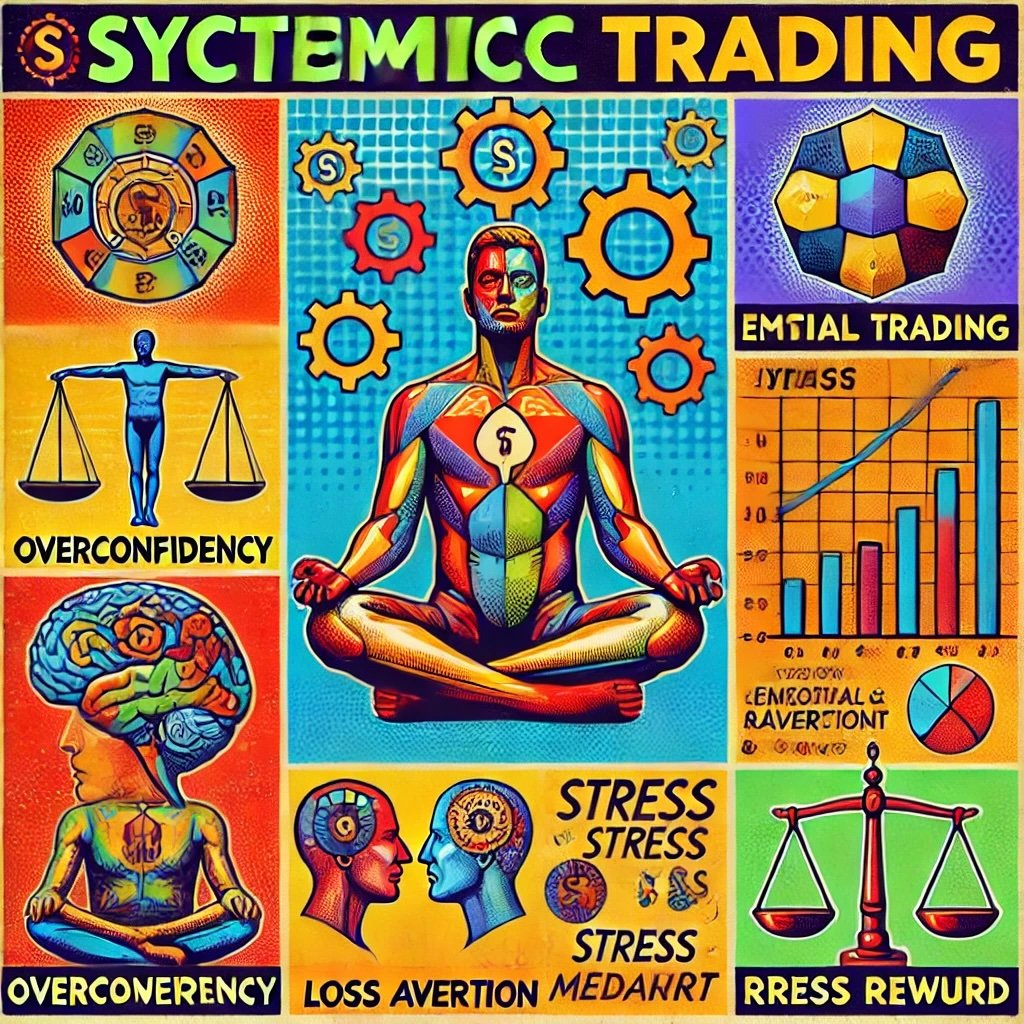
The Role of Psychology in Trading
Dunn’s Views on the Psychological Challenges of Systematic Trading
Bill Dunn recognizes that trading is as much a psychological endeavor as it is a technical one. The emotional highs and lows, the pressure of making quick decisions, and the fear of losses can significantly impact trading performance. Dunn emphasizes the importance of mastering the psychological aspects of trading to achieve consistent success.
Key Psychological Challenges:
- Emotional Trading: Making decisions based on emotions like fear, greed, or excitement rather than rational analysis.
- Overconfidence: Believing too much in one’s own trading abilities, leading to excessive risk-taking.
- Loss Aversion: The tendency to prefer avoiding losses over acquiring gains, which can result in holding onto losing positions too long.
- Stress and Pressure: Managing the stress that comes with the high-stakes environment of trading.
Techniques for Maintaining Discipline and Emotional Control
To navigate the psychological challenges of trading, Dunn employs several techniques aimed at fostering discipline and emotional resilience:
- Structured Trading Plan: Having a detailed trading plan that outlines entry and exit criteria, risk management rules, and performance benchmarks helps maintain focus and prevent impulsive decisions.
- Mindfulness and Stress Management: Practices like meditation, deep breathing exercises, and regular physical activity help Dunn manage stress and maintain mental clarity, enabling him to stay calm and focused during trading sessions.
- Regular Performance Reviews: Conducting periodic reviews of his trading performance allows Dunn to identify patterns of emotional decision-making and adjust his strategies accordingly.
- Goal Setting: Setting clear, achievable trading goals provides direction and motivation, helping Dunn stay committed to his strategies even during challenging market conditions.
Example: During a volatile market day, Dunn remains calm and adheres to his trading plan instead of succumbing to panic selling or impulsive buying. This disciplined approach helps him navigate turbulent markets without incurring unnecessary losses.
Tip: Develop a structured routine that includes stress management techniques and regular performance reviews to maintain emotional control and discipline in your trading.
The Importance of Mental Resilience and Adaptability in Executing Trades Effectively
Mental resilience is crucial for overcoming the inevitable setbacks and challenges in trading. Dunn emphasizes the need to build mental toughness to handle losses, stay motivated, and maintain a positive outlook.
Strategies to Build Mental Resilience:
- Acceptance of Losses: Recognizing that losses are a natural part of trading and learning from them rather than dwelling on them.
- Positive Mindset: Maintaining a positive attitude and focusing on long-term goals instead of short-term setbacks.
- Continuous Learning: Viewing each trading experience as an opportunity to learn and improve, thereby fostering a growth mindset.
- Support Systems: Engaging with mentors, peers, and support networks to gain perspective and encouragement during tough times.
Example: After experiencing a series of losing trades, Dunn reviews his strategies to identify areas for improvement. Instead of getting discouraged, he uses the experience as a learning opportunity to refine his approach and enhance his future trading performance.
Tip: Cultivate a growth mindset by viewing challenges as opportunities for learning and improvement. This approach helps you stay resilient and adaptable in the face of trading setbacks.
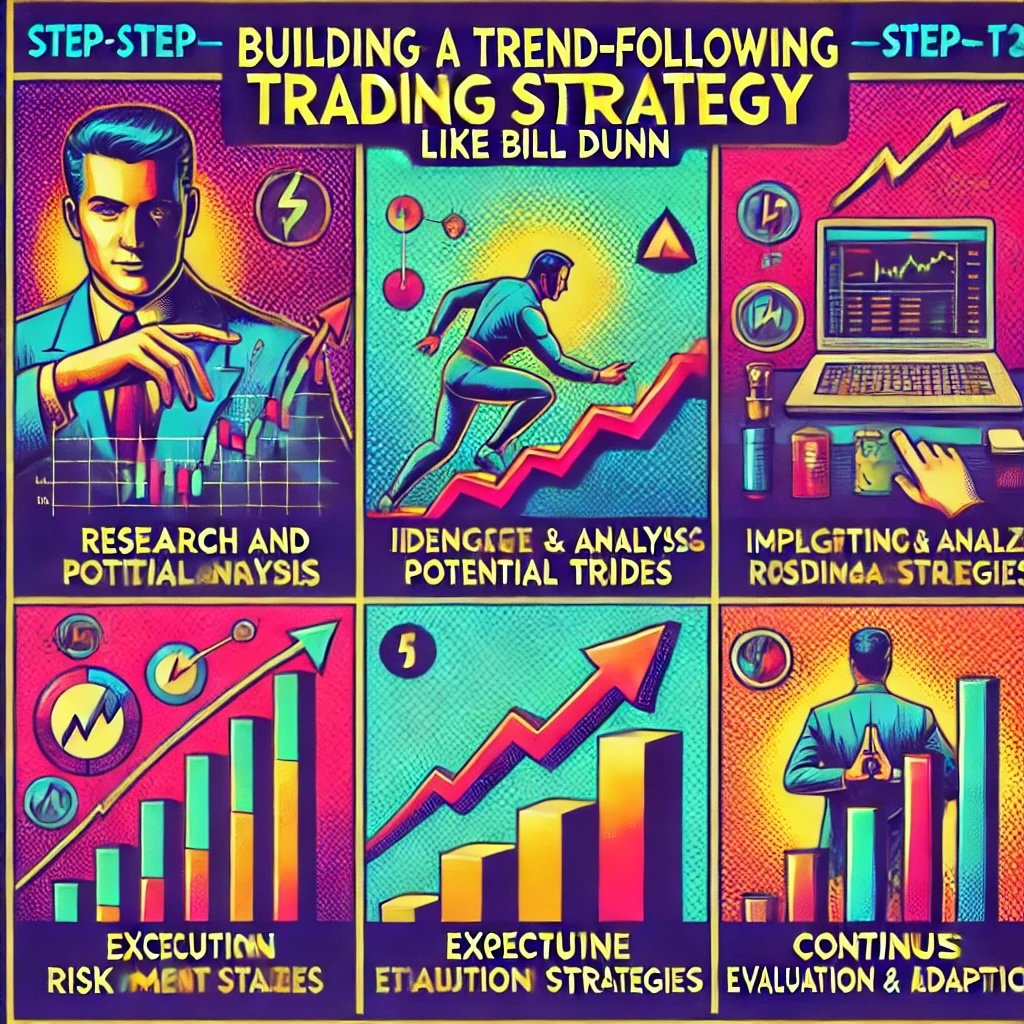
Building a Trend-Following Strategy Like Bill Dunn
Step-by-Step Guide to Developing a Trend-Following Strategy Inspired by Dunn
Emulating Bill Dunn’s trading strategies involves adopting his disciplined approach to quantitative analysis, risk management, and psychological resilience. Here’s a practical guide to developing a trend-following strategy inspired by Dunn.
1. Research and Analysis
- Comprehensive Market Research: Begin by conducting thorough research on the options and commodities you intend to trade. Understand the factors that influence price movements, such as supply and demand dynamics, economic indicators, and geopolitical events.
- Technical and Fundamental Analysis: Combine technical analysis (chart patterns, moving averages, RSI) with fundamental analysis (earnings reports, economic indicators) to identify high-potential trading opportunities.
- Use of Proprietary Indicators: Incorporate tools like Dunn’s proprietary quantitative models and algorithms to gain deeper insights into market sentiment and momentum.
2. Identifying and Analyzing Potential Trades
- Option Selection Criteria: Establish clear criteria for selecting options contracts, such as liquidity, volatility, and the underlying asset’s performance.
- Trend Identification: Use moving averages and trendlines to identify prevailing market trends, ensuring alignment with your trading strategy.
- Volatility Assessment: Analyze implied and realized volatility to determine the potential profitability of options trades. Dunn often seeks to exploit discrepancies between implied and realized volatility.
3. Implementing Risk Management Strategies
- Stop-Loss Orders: Set stop-loss orders for each trade to limit potential losses and protect your capital.
- Position Sizing: Determine the appropriate size of each position based on the risk profile of the option and your overall portfolio strategy.
- Diversification: Spread your investments across different options and underlying assets to mitigate the impact of sector-specific downturns.
4. Executing the Trading Plan
- Strategic Entry and Exit Points: Identify optimal entry points using technical indicators and quantitative signals, and set predefined exit points to lock in profits or limit losses.
- Automated Trading Systems: Utilize automated trading systems to execute trades based on your quantitative models, ensuring consistency and speed.
- Continuous Monitoring: Regularly monitor your trades and the broader market conditions to ensure that your positions remain aligned with your trading objectives.
5. Continuous Evaluation and Adaptation
- Performance Review: Conduct regular reviews of your trading performance to assess the effectiveness of your strategies and identify areas for improvement.
- Adapt to Market Conditions: Be prepared to adjust your strategies based on changing market dynamics, economic indicators, and emerging trends.
- Innovate and Refine: Incorporate new trading techniques and tools to enhance your strategy and stay ahead of market developments.
Tips for Refining and Adapting the Strategy Over Time
- Stay Flexible: Be willing to pivot your strategy as new information and trends emerge. Flexibility allows you to capitalize on unexpected opportunities and mitigate emerging risks.
- Learn Continuously: Invest in your education to stay ahead of market developments. Attend seminars, read extensively, and engage with financial experts to enhance your knowledge.
- Seek Expertise: Collaborate with analysts and industry experts to gain diverse perspectives. Leveraging specialized knowledge can provide deeper insights into complex markets.
- Implement Feedback Loops: Use feedback from performance reviews and market analyses to iteratively improve your strategy, ensuring it remains robust and effective.
Tip: Regularly review and adjust your trading strategy to incorporate new insights and respond to evolving market conditions, ensuring sustained performance and growth.
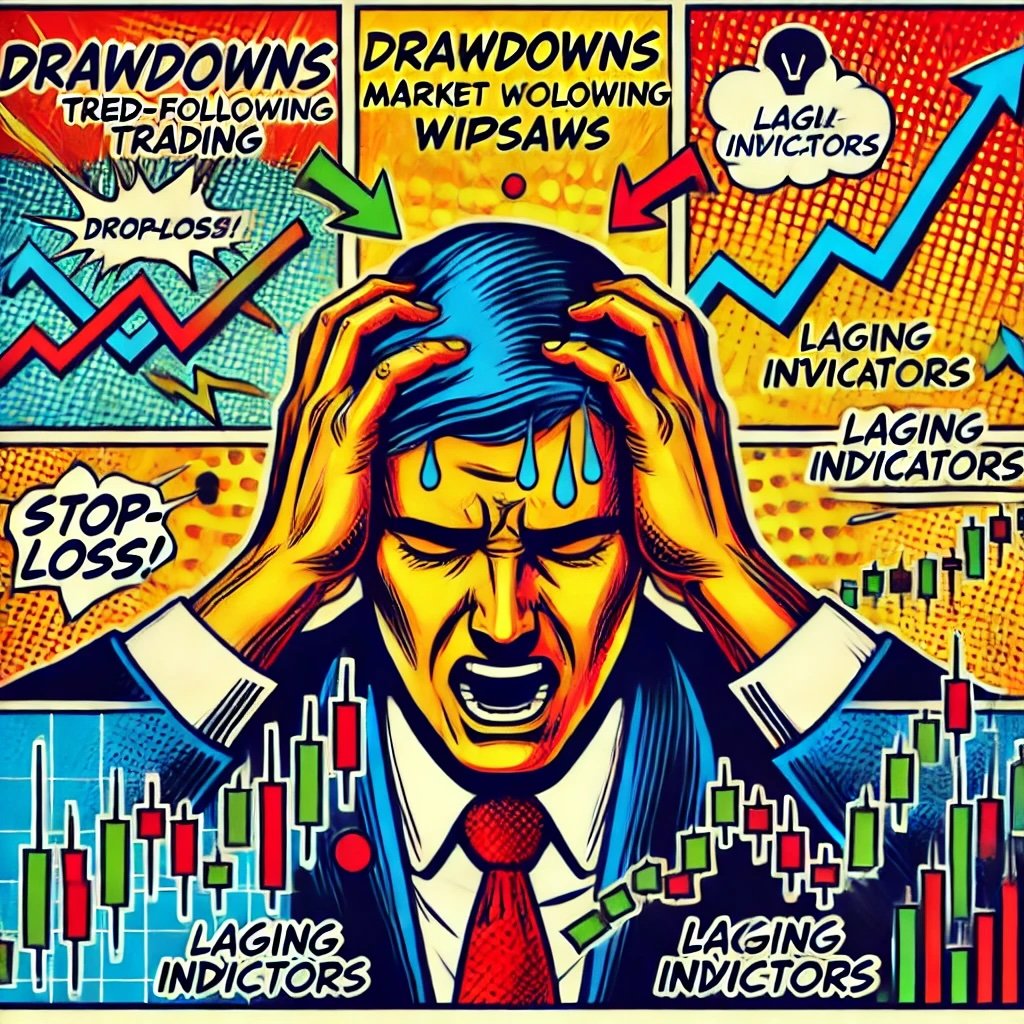
Challenges of Trend-Following Trading
Potential Pitfalls and Difficulties in Adopting a Trend-Following Approach
Adopting a trend-following approach presents several challenges that require strategic planning and disciplined execution to overcome. Understanding these potential pitfalls is essential for developing a resilient and effective trading strategy.
Common Challenges:
- Drawdowns: Periods of significant losses during trend reversals can test a trader’s resilience and risk management strategies.
- Market Whipsaws: False signals and short-term reversals can lead to frequent stop-outs and reduced trading efficiency.
- Lagging Indicators: Trend-following strategies often rely on lagging indicators, which can delay entry and exit points, potentially missing optimal trade opportunities.
- Overfitting: Developing overly complex models that perform well on historical data but poorly in live trading environments.
- Psychological Stress: Managing emotions during prolonged drawdowns or high-frequency trading scenarios can be challenging.
How to Overcome Common Challenges
1. Managing Drawdowns
- Implement Robust Risk Controls: Use strict stop-loss orders and position sizing to limit the impact of individual trades on the overall portfolio.
- Diversify Trading Strategies: Incorporate multiple trend-following strategies across different asset classes to spread risk and reduce the likelihood of simultaneous losses.
- Maintain Emotional Discipline: Stick to your trading plan and avoid making impulsive decisions based on short-term losses.
2. Navigating Market Whipsaws
- Use Confirmation Indicators: Combine multiple technical indicators to confirm trend signals, reducing the likelihood of acting on false signals.
- Adjust Stop-Loss Levels: Implement dynamic stop-loss levels that adapt to market volatility, allowing for flexibility during whipsaws.
- Filter Noise: Focus on high-probability trades and filter out low-confidence signals to enhance trading efficiency.
3. Addressing Lagging Indicators
- Incorporate Leading Indicators: Blend lagging indicators with leading ones to anticipate trend changes and improve entry and exit timing.
- Combine with Price Action: Use price action analysis to complement indicator-based signals, enhancing the accuracy of trend identification.
4. Preventing Overfitting
- Simplify Models: Develop models that are robust and based on fundamental market principles rather than overly complex patterns.
- Forward Testing: Test your models on out-of-sample data to ensure they perform well in live trading environments.
- Continuous Refinement: Regularly review and refine your models based on live trading performance and changing market conditions.
5. Managing Psychological Stress
- Build Mental Resilience: Cultivate a strong mindset through practices like meditation, exercise, and regular breaks to manage stress effectively.
- Set Realistic Expectations: Understand that drawdowns are a natural part of trading and focus on long-term performance rather than short-term fluctuations.
- Seek Support: Engage with trading communities or mentors to share experiences and gain perspective during challenging times.
Tip: Develop a comprehensive understanding of the specific challenges associated with trend-following and implement targeted strategies to mitigate these risks effectively.
The Importance of Adaptability and Continuous Improvement in Trading Systems
In the dynamic environment of trend-following trading, adaptability and continuous improvement are crucial for sustained success. Markets evolve rapidly, influenced by technological advancements, regulatory changes, and shifting economic conditions. Traders must remain vigilant and proactive to stay ahead of these changes.
Key Practices for Adaptability and Continuous Improvement:
- Regular System Reviews: Periodically assess the performance of your trading systems and make necessary adjustments to maintain effectiveness.
- Stay Informed: Keep abreast of market trends, economic indicators, and technological advancements to inform your trading strategies.
- Innovate and Experiment: Continuously seek out new trading techniques and experiment with different approaches to enhance your trading performance.
- Feedback Integration: Incorporate feedback from trading performance reviews to refine and optimize your strategies, ensuring they remain robust and effective.
Example: When market dynamics shift due to a geopolitical event, Dunn promptly adjusts his trend-following models to account for the new factors influencing price movements, ensuring that his strategies remain aligned with the current market environment.
Tip: Cultivate a mindset of continuous learning and adaptability, ensuring that your trading strategies remain relevant and effective in evolving market environments.
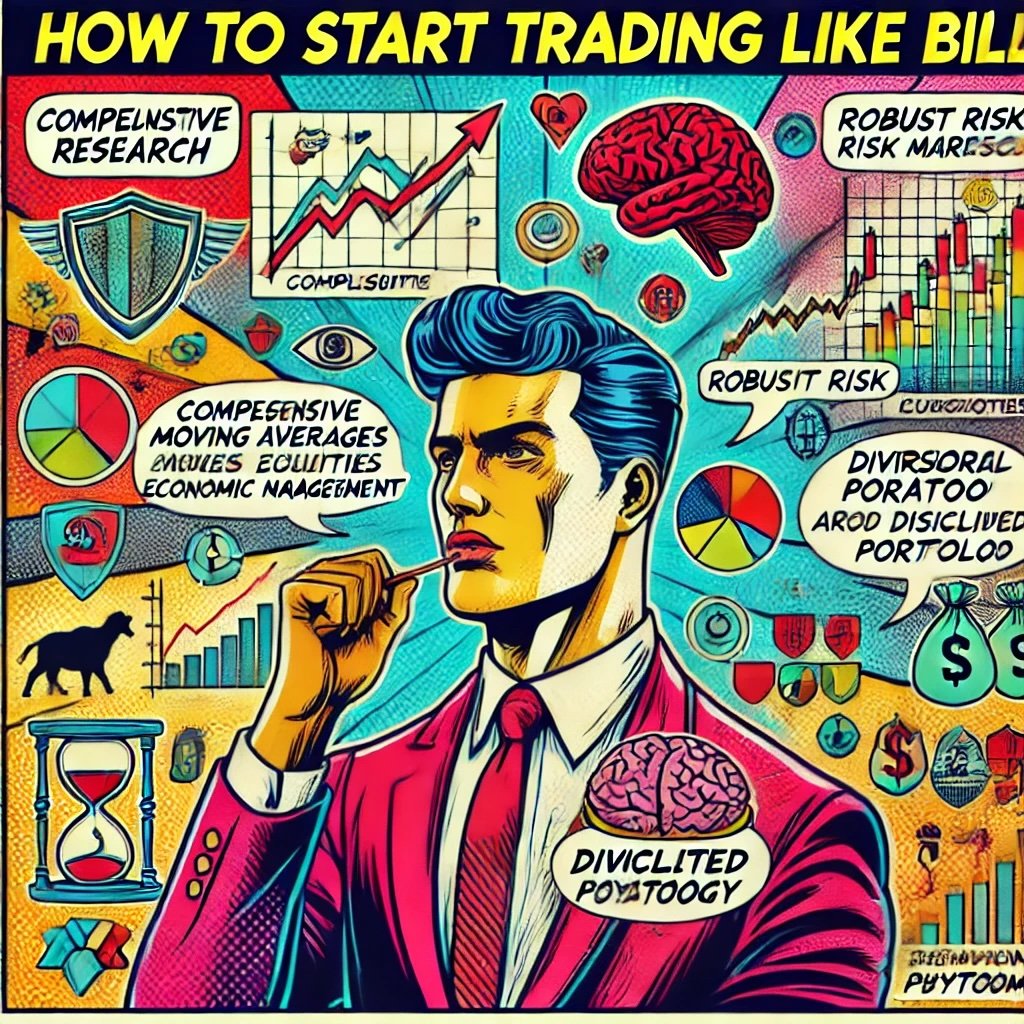
How to Start Trading Like Bill Dunn
Practical Steps for Implementing Dunn’s Strategies in Your Own Trading
Emulating Bill Dunn’s trading strategies involves adopting his disciplined approach to quantitative analysis, risk management, and psychological resilience. Here’s a practical guide to implementing Dunn’s strategies in your own trading.
1. Develop a Comprehensive Research Process
- In-Depth Analysis: Conduct thorough research on the options and commodities you intend to trade. Understand the factors that influence price movements, such as supply and demand dynamics, economic indicators, and geopolitical events.
- Technical and Fundamental Analysis: Combine technical analysis (chart patterns, moving averages, RSI) with fundamental analysis (earnings reports, economic indicators) to identify high-potential trading opportunities.
- Use of Proprietary Indicators: Incorporate tools like Dunn’s proprietary quantitative models and algorithms to gain deeper insights into market sentiment and momentum.
2. Implement Robust Risk Management Practices
- Capital Preservation: Prioritize the protection of your invested capital by avoiding overly risky trades and focusing on high-probability setups.
- Position Sizing: Determine the appropriate size of each position based on the risk profile of the option and your overall portfolio strategy.
- Use of Stop-Loss Orders: Implement stop-loss orders to limit potential losses and protect your capital from significant downturns.
3. Adopt a Diversified Portfolio Approach
- Asset Class Diversification: Invest across various options and underlying assets to spread risk and enhance portfolio stability.
- Sector and Geographic Diversification: Spread your investments across different sectors and regions to mitigate the impact of sector-specific downturns or regional economic challenges.
- Balanced Exposure: Ensure a balanced exposure to high-growth and defensive sectors to maintain portfolio stability.
4. Integrate Behavioral Finance Principles
- Recognize Biases: Identify and mitigate common cognitive biases that can impair investment decision-making.
- Maintain Emotional Discipline: Stick to your investment plan and avoid making impulsive decisions based on emotions.
- Focus on Long-Term Goals: Prioritize long-term growth over short-term gains to ensure sustained investment performance.
5. Maintain an Adaptive Investment Strategy
- Monitor Market Conditions: Continuously assess market conditions and adjust your investment strategy accordingly.
- Stay Flexible: Be prepared to pivot your strategy in response to new information, emerging trends, and changing market dynamics.
- Innovate and Refine: Incorporate new trading techniques and tools to enhance your strategy and stay ahead of market developments.
Resources for Learning More About Trend-Following and Systematic Trading Techniques
- Books:
- “Trend Following: Learn to Make Millions in Up or Down Markets” by Michael W. Covel
- “Market Wizards” by Jack D. Schwager
- “Quantitative Trading: How to Build Your Own Algorithmic Trading Business” by Ernest P. Chan
- Online Courses:
- Coursera’s Financial Engineering and Risk Management specialization
- Udemy’s Algorithmic Trading & Quantitative Analysis Using Python
- edX’s Introduction to Computational Finance and Financial Econometrics
- Professional Certifications:
- Chartered Financial Analyst (CFA)
- Chartered Market Technician (CMT)
- Seminars and Webinars:
- Attend industry conferences and webinars hosted by reputable financial institutions and trading firms.
- Participate in online trading communities and forums to exchange insights and strategies with other traders.
Tools and Platforms to Support Trend-Following Trading Activities
- Analytical Tools:
- Bloomberg Terminal: Comprehensive platform for financial data, news, and analytics.
- TradingView: Advanced charting platform with a wide range of technical indicators and social networking features for traders.
- MetaTrader 4/5: Popular trading platforms offering extensive technical analysis tools and automated trading capabilities.
- Trading Platforms:
- Interactive Brokers: Offers low-cost commissions, advanced trading tools, and a wide range of investment options.
- Thinkorswim by TD Ameritrade: Robust platform with advanced charting and trading capabilities.
- E*TRADE Pro: Professional-grade trading platform with extensive research tools and real-time data.
- Portfolio Management Software:
- Portfolio Visualizer: Tool for portfolio analysis, backtesting, and optimization.
- Personal Capital: Comprehensive financial planning and portfolio management platform.
- Quicken: Personal finance management tool with investment tracking features.
Tip: Invest in high-quality analytical and trading tools to enhance your investment analysis and execution capabilities, enabling you to make informed and strategic trading decisions.

Bill Dunn–Style Trend Following FAQ: Rules-Based CTAs, Risk Discipline, and How to Get Started
What makes Bill Dunn’s approach distinct in managed futures?
Bill Dunn’s style is “pure” systematic trend following: diversified global futures, simple rule sets (breakouts/moving-average filters), strict risk caps, and the resolve to hold winners and cut losers—without discretionary overrides.
How does a Dunn-style system find trends?
It scans many liquid futures (rates, FX, equity indices, energies, metals, ags) for price breakouts or moving-average alignment. When signals confirm across lookbacks, it enters with predefined stops and sizes positions by volatility.
Why so much diversification?
Trends rotate. Broad market coverage increases the chance that at least some contracts are trending (e.g., short bonds, long cocoa, short JPY, long copper), smoothing the equity curve relative to betting on one theme.
How are positions sized?
Volatility (e.g., ATR) normalizes risk so each trade risks a similar fraction of capital. As volatility rises, position size falls; as volatility drops, size can increase—keeping portfolio risk more stable.
What risk controls are typical?
Pre-trade risk limits, initial and trailing stops, per-market and per-sector caps, gross and net exposure limits, and portfolio-level drawdown brakes. No averaging down; losers are cut, not “managed.”
How does a system exit?
Losers hit hard stops; winners trail with rules (e.g., opposite breakout, moving-average cross, or volatility-adjusted stop). Exits are mechanical to avoid discretion creep.
What returns should investors expect?
Long-run positive expectancy with material volatility and deep, multi-month drawdowns. Payoffs tend to spike during sustained trends and crisis periods; flat or negative during choppy, mean-reverting regimes.
How does this help a traditional 60/40 portfolio?
Managed futures have low/negative correlation to stocks and bonds at critical times. Trend following can provide convex “crisis alpha,” improving portfolio diversification and drawdown control.
What are the biggest psychological hurdles?
Sticking to rules through whipsaws, dry spells, and drawdowns. The edge comes from consistency; abandoning the system during pain forfeits the payoff when the next big trend arrives.
How do I avoid overfitting a trend system?
Prefer simple, transparent rules, test across decades and many markets, use walk-forward/out-of-sample validation, include realistic costs, and seek robustness over perfect in-sample metrics.
What does an individual’s starter playbook look like?
Pick a liquid multi-asset futures/ETFs universe, choose one or two robust entry/exit rules, size by volatility (risk per trade/portfolio caps), automate as much as possible, and review monthly with a written checklist.
How do fees, slippage, and financing affect results?
They’re the difference between theory and practice. Use liquid contracts, conservative friction assumptions in tests, and disciplined execution (limit/stop logic, roll calendars) to protect edge.
Summary of the Key Takeaways from Bill Dunn’s Trading Approach
Bill Dunn’s trading approach is a blend of disciplined quantitative analysis, robust risk management, trend following, and continuous improvement. By focusing on preserving capital, managing downside risks, and maintaining a diversified and adaptable portfolio, Dunn has consistently delivered impressive returns through his expertise in trend-following trading.
Key Takeaways:
- Trend Following: Emphasizing the identification and riding of long-term market trends to maximize returns.
- Systematic Trading: Relying on data-driven systems and algorithms to remove emotional biases and ensure consistent execution.
- Risk Management: Prioritizing capital preservation through position sizing, stop-loss orders, and diversification.
- Diversification: Spreading investments across various asset classes, sectors, and geographies to mitigate risk and enhance portfolio stability.
- Psychological Resilience: Building mental toughness to handle drawdowns, market volatility, and trading pressures.
- Continuous Improvement: Committing to ongoing research, performance analysis, and strategy refinement to stay ahead of market developments.
- Technological Integration: Leveraging advanced trading platforms and quantitative models to execute trades with precision and speed.
- Adaptability: Adjusting trading strategies based on changing market conditions and emerging trends to maintain effectiveness.
Relevance of Trend-Following in Today’s Markets
In today’s fast-paced and technologically driven financial markets, the principles of trend-following remain highly relevant. The integration of quantitative analysis and advanced technology is more accessible than ever, allowing traders to implement data-driven strategies that can adapt to rapid market changes. Dunn’s emphasis on robust risk management and continuous improvement provides a solid framework for navigating the complexities of modern trend-following trading.
Relevance in Modern Markets:
- Technological Advancements: Leveraging advanced analytical tools and proprietary algorithms enhances the ability to make informed trading decisions and execute strategies with precision.
- Globalization: Understanding global economic trends and their impact on various markets helps in making strategic investment choices.
- Market Volatility: Robust risk management techniques are essential for protecting capital and sustaining long-term performance in volatile markets.
- Behavioral Insights: Incorporating behavioral finance principles helps in mitigating emotional biases and improving trading discipline.
Example: In an era where algorithmic trading and high-frequency trading dominate, Dunn’s balanced approach—combining quantitative analysis with disciplined risk management—offers a resilient strategy that can withstand the rapid fluctuations of modern markets.
Important Information
Comprehensive Investment Disclaimer:
All content provided on this website (including but not limited to portfolio ideas, fund analyses, investment strategies, commentary on market conditions, and discussions regarding leverage) is strictly for educational, informational, and illustrative purposes only. The information does not constitute financial, investment, tax, accounting, or legal advice. Opinions, strategies, and ideas presented herein represent personal perspectives, are based on independent research and publicly available information, and do not necessarily reflect the views or official positions of any third-party organizations, institutions, or affiliates.
Investing in financial markets inherently carries substantial risks, including but not limited to market volatility, economic uncertainties, geopolitical developments, and liquidity risks. You must be fully aware that there is always the potential for partial or total loss of your principal investment. Additionally, the use of leverage or leveraged financial products significantly increases risk exposure by amplifying both potential gains and potential losses, and thus is not appropriate or advisable for all investors. Using leverage may result in losing more than your initial invested capital, incurring margin calls, experiencing substantial interest costs, or suffering severe financial distress.
Past performance indicators, including historical data, backtesting results, and hypothetical scenarios, should never be viewed as guarantees or reliable predictions of future performance. Any examples provided are purely hypothetical and intended only for illustration purposes. Performance benchmarks, such as market indexes mentioned on this site, are theoretical and are not directly investable. While diligent efforts are made to provide accurate and current information, “Picture Perfect Portfolios” does not warrant, represent, or guarantee the accuracy, completeness, or timeliness of any information provided. Errors, inaccuracies, or outdated information may exist.
Users of this website are strongly encouraged to independently verify all information, conduct comprehensive research and due diligence, and engage with qualified financial, investment, tax, or legal professionals before making any investment or financial decisions. The responsibility for making informed investment decisions rests entirely with the individual. “Picture Perfect Portfolios” explicitly disclaims all liability for any direct, indirect, incidental, special, consequential, or other losses or damages incurred, financial or otherwise, arising out of reliance upon, or use of, any content or information presented on this website.
By accessing, reading, and utilizing the content on this website, you expressly acknowledge, understand, accept, and agree to abide by these terms and conditions. Please consult the full and detailed disclaimer available elsewhere on this website for further clarification and additional important disclosures. Read the complete disclaimer here.




